Anatomy
| Part of a series on |
| Biology |
|---|
Anatomy (from
Anatomy is a complex and dynamic field that is constantly evolving as new discoveries are made. In recent years, there has been a significant increase in the use of advanced imaging techniques, such as MRI and CT scans, which allow for more detailed and accurate visualizations of the body's structures.
The discipline of anatomy is divided into
The
Etymology and definition

Derived from the Greek ἀνατομή anatomē "dissection" (from ἀνατέμνω anatémnō "I cut up, cut open" from ἀνά aná "up", and τέμνω témnō "I cut"),[7] anatomy is the scientific study of the structure of organisms including their systems, organs and tissues. It includes the appearance and position of the various parts, the materials from which they are composed, and their relationships with other parts. Anatomy is quite distinct from physiology and biochemistry, which deal respectively with the functions of those parts and the chemical processes involved. For example, an anatomist is concerned with the shape, size, position, structure, blood supply and innervation of an organ such as the liver; while a physiologist is interested in the production of bile, the role of the liver in nutrition and the regulation of bodily functions.[8]
The discipline of anatomy can be subdivided into a number of branches, including gross or
Anatomy can be studied using both invasive and non-invasive methods with the goal of obtaining information about the structure and organization of organs and systems.[3] Methods used include dissection, in which a body is opened and its organs studied, and endoscopy, in which a video camera-equipped instrument is inserted through a small incision in the body wall and used to explore the internal organs and other structures. Angiography using X-rays or magnetic resonance angiography are methods to visualize blood vessels.[11][12][13][14]
The term "anatomy" is commonly taken to refer to
Animal tissues

The
Unlike
Animal tissues can be grouped into four basic types:

Connective tissue
Epithelium
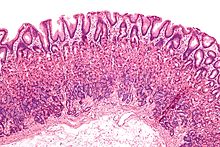
Muscle tissue
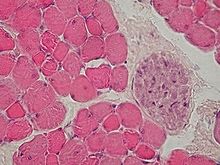
Nervous tissue
Vertebrate anatomy
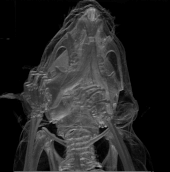
All
Fish anatomy

The body of a fish is divided into a head, trunk and tail, although the divisions between the three are not always externally visible. The skeleton, which forms the support structure inside the fish, is either made of cartilage, in
Sharks and rays are
The bony fish lineage shows more
Amphibian anatomy
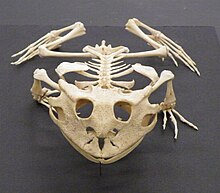

In frogs the pelvic girdle is robust and the hind legs are much longer and stronger than the forelimbs. The feet have four or five digits and the toes are often webbed for swimming or have suction pads for climbing. Frogs have large eyes and no tail. Salamanders resemble lizards in appearance; their short legs project sideways, the belly is close to or in contact with the ground and they have a long tail. Caecilians superficially resemble earthworms and are limbless. They burrow by means of zones of muscle contractions which move along the body and they swim by undulating their body from side to side.[35]
Reptile anatomy

Reptiles are a class of animals comprising turtles, tuataras, lizards, snakes and crocodiles. They are tetrapods, but the snakes and a few species of lizard either have no limbs or their limbs are much reduced in size. Their bones are better ossified and their skeletons stronger than those of amphibians. The teeth are conical and mostly uniform in size. The surface cells of the epidermis are modified into horny scales which create a waterproof layer. Reptiles are unable to use their skin for respiration as do amphibians and have a more efficient respiratory system drawing air into their lungs by expanding their chest walls. The heart resembles that of the amphibian but there is a septum which more completely separates the oxygenated and deoxygenated bloodstreams. The reproductive system has evolved for internal fertilization, with a copulatory organ present in most species. The eggs are surrounded by amniotic membranes which prevents them from drying out and are laid on land, or develop internally in some species. The bladder is small as nitrogenous waste is excreted as uric acid.[36]
Turtles are notable for their protective shells. They have an inflexible trunk encased in a horny
Tuataras superficially resemble lizards but the lineages diverged in the
Lizards have skulls with only one
Snakes are closely related to lizards, having branched off from a common ancestral lineage during the Cretaceous period, and they share many of the same features. The skeleton consists of a skull, a hyoid bone, spine and ribs though a few species retain a vestige of the pelvis and rear limbs in the form of pelvic spurs. The bar under the second fenestra has also been lost and the jaws have extreme flexibility allowing the snake to swallow its prey whole. Snakes lack moveable eyelids, the eyes being covered by transparent "spectacle" scales. They do not have eardrums but can detect ground vibrations through the bones of their skull. Their forked tongues are used as organs of taste and smell and some species have sensory pits on their heads enabling them to locate warm-blooded prey.[38]
Bird anatomy

Birds are
The feathers are outgrowths of the epidermis and are found in localized bands from where they fan out over the skin. Large flight feathers are found on the wings and tail, contour feathers cover the bird's surface and fine down occurs on young birds and under the contour feathers of water birds. The only cutaneous gland is the single uropygial gland near the base of the tail. This produces an oily secretion that waterproofs the feathers when the bird preens. There are scales on the legs, feet and claws on the tips of the toes.[40]
Mammal anatomy
Mammals are a diverse class of animals, mostly terrestrial but some are aquatic and others have evolved flapping or gliding flight. They mostly have four limbs, but some aquatic mammals have no limbs or limbs modified into fins, and the forelimbs of bats are modified into wings. The legs of most mammals are situated below the trunk, which is held well clear of the ground. The bones of mammals are well ossified and their teeth, which are usually differentiated, are coated in a layer of prismatic enamel. The teeth are shed once (milk teeth) during the animal's lifetime or not at all, as is the case in cetaceans. Mammals have three bones in the middle ear and a cochlea in the inner ear. They are clothed in hair and their skin contains glands which secrete sweat. Some of these glands are specialized as mammary glands, producing milk to feed the young. Mammals breathe with lungs and have a muscular diaphragm separating the thorax from the abdomen which helps them draw air into the lungs. The mammalian heart has four chambers, and oxygenated and deoxygenated blood are kept entirely separate. Nitrogenous waste is excreted primarily as urea.[41]
Mammals are
Human anatomy
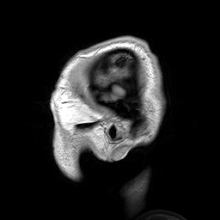

Generally, students of certain biological sciences, paramedics, prosthetists and orthotists, physiotherapists, occupational therapists, nurses, podiatrists, and medical students learn gross anatomy and microscopic anatomy from anatomical models, skeletons, textbooks, diagrams, photographs, lectures and tutorials and in addition, medical students generally also learn gross anatomy through practical experience of dissection and inspection of cadavers. The study of microscopic anatomy (or histology) can be aided by practical experience examining histological preparations (or slides) under a microscope.[43]
Human anatomy, physiology and biochemistry are complementary basic medical sciences, which are generally taught to medical students in their first year at medical school. Human anatomy can be taught regionally or systemically; that is, respectively, studying anatomy by bodily regions such as the head and chest, or studying by specific systems, such as the nervous or respiratory systems.[3] The major anatomy textbook, Gray's Anatomy, has been reorganized from a systems format to a regional format, in line with modern teaching methods.[44][45] A thorough working knowledge of anatomy is required by physicians, especially surgeons and doctors working in some diagnostic specialties, such as histopathology and radiology.[46]
Academic anatomists are usually employed by universities, medical schools or teaching hospitals. They are often involved in teaching anatomy, and research into certain systems, organs, tissues or cells.[46]
Invertebrate anatomy
Invertebrates constitute a vast array of living organisms ranging from the simplest unicellular eukaryotes such as Paramecium to such complex multicellular animals as the octopus, lobster and dragonfly. They constitute about 95% of the animal species. By definition, none of these creatures has a backbone. The cells of single-cell protozoans have the same basic structure as those of multicellular animals but some parts are specialized into the equivalent of tissues and organs. Locomotion is often provided by cilia or flagella or may proceed via the advance of pseudopodia, food may be gathered by phagocytosis, energy needs may be supplied by photosynthesis and the cell may be supported by an endoskeleton or an exoskeleton. Some protozoans can form multicellular colonies.[47]
Marcello Malpighi, the father of microscopical anatomy, discovered that plants had tubules similar to those he saw in insects like the silk worm. He observed that when a ring-like portion of bark was removed on a trunk a swelling occurred in the tissues above the ring, and he unmistakably interpreted this as growth stimulated by food coming down from the leaves, and being captured above the ring.[50]
Arthropod anatomy
Arthropods comprise the largest phylum of invertebrates in the animal kingdom with over a million known species.[51]
Spiders a class of arachnids have four pairs of legs; a body of two segments—a cephalothorax and an abdomen. Spiders have no wings and no antennae. They have mouthparts called chelicerae which are often connected to venom glands as most spiders are venomous. They have a second pair of appendages called pedipalps attached to the cephalothorax. These have similar segmentation to the legs and function as taste and smell organs. At the end of each male pedipalp is a spoon-shaped cymbium that acts to support the copulatory organ.
Other branches of anatomy
- Surface anatomy is important as the study of anatomical landmarks that can be readily seen from the exterior contours of the body.[3] It enables medics and veterinarians to gauge the position and anatomy of the associated deeper structures. Superficial is a directional term that indicates that structures are located relatively close to the surface of the body.[55]
- Comparative anatomy relates to the comparison of anatomical structures (both gross and microscopic) in different animals.[3]
- Artistic anatomy relates to anatomic studies of body proportionsfor artistic reasons.
History
Ancient

In 1600 BCE, the
Ancient Greek anatomy and physiology underwent great changes and advances throughout the early medieval world. Over time, this medical practice expanded by a continually developing understanding of the functions of organs and structures in the body. Phenomenal anatomical observations of the human body were made, which have contributed towards the understanding of the brain, eye, liver, reproductive organs and the nervous system.
The

Some of the most striking advances in early anatomy and physiology took place in Hellenistic Alexandria.


Great feats were made during the third century BCE in both the digestive and reproductive systems. Herophilus was able to discover and describe not only the salivary glands, but the small intestine and liver.[67] He showed that the uterus is a hollow organ and described the ovaries and uterine tubes. He recognized that spermatozoa were produced by the testes and was the first to identify the prostate gland.[67]
The anatomy of the muscles and skeleton is described in the Hippocratic Corpus, an Ancient Greek medical work written by unknown authors.[68] Aristotle described vertebrate anatomy based on animal dissection. Praxagoras identified the difference between arteries and veins. Also in the 4th century BCE, Herophilos and Erasistratus produced more accurate anatomical descriptions based on vivisection of criminals in Alexandria during the Ptolemaic period.[69][70]
In the 2nd century,
Medieval to early modern

Anatomy developed little from classical times until the sixteenth century; as the historian Marie Boas writes, "Progress in anatomy before the sixteenth century is as mysteriously slow as its development after 1500 is startlingly rapid".[74]: 120–121 Between 1275 and 1326, the anatomists Mondino de Luzzi, Alessandro Achillini and Antonio Benivieni at Bologna carried out the first systematic human dissections since ancient times.[75][76][77] Mondino's Anatomy of 1316 was the first textbook in the medieval rediscovery of human anatomy. It describes the body in the order followed in Mondino's dissections, starting with the abdomen, then the thorax, then the head and limbs. It was the standard anatomy textbook for the next century.[74]
Leonardo da Vinci (1452–1519) was trained in anatomy by Andrea del Verrocchio.[74] He made use of his anatomical knowledge in his artwork, making many sketches of skeletal structures, muscles and organs of humans and other vertebrates that he dissected.[74][78]
In England, anatomy was the subject of the first public lectures given in any science; these were given by the Company of Barbers and Surgeons in the 16th century, joined in 1583 by the Lumleian lectures in surgery at the Royal College of Physicians.[82]
Late modern

In the United States, medical schools began to be set up towards the end of the 18th century. Classes in anatomy needed a continual stream of cadavers for dissection and these were difficult to obtain. Philadelphia, Baltimore and New York were all renowned for
The teaching of anatomy in Britain was transformed by Sir

Before the modern medical era, the main means for studying the internal structures of the body were
Equally important advances have occurred in non-invasive techniques for examining the interior structures of the body.
See also
- Anatomical model
- Bibliography of biology § Anatomy
- Outline of human anatomy
- Plastination
 Anatomy portal
Anatomy portal
References
- ^ "anatomy". Merriam-Webster.com Dictionary.
- ^ Rotimi, Booktionary. "Anatomy". Archived from the original on 1 August 2017. Retrieved 18 June 2017.
- ^ a b c d e f Gray, Henry (1918). "Introduction". Anatomy of the Human Body (20th ed.). Archived from the original on 16 March 2007. Retrieved 19 March 2007 – via Bartleby.com.
- PMID 20591641.
- PMID 26417475.
- ^ a b "Anatomical Imaging". McGraw Hill Higher Education. 1998. Archived from the original on 3 March 2016. Retrieved 25 June 2013.
- ^ O.D.E. 2nd edition 2005
- ^ ASIN B0066E44EC.
- ^ "Anatomy". The Free Dictionary. Farlex. 2007. Archived from the original on 15 November 2018. Retrieved 8 July 2013.
- ISBN 978-1-947172-04-3. Archivedfrom the original on 3 April 2023. Retrieved 14 May 2023.
- JSTOR 1549093.
- PMID 10484138.
- ^ "Magnetic Resonance Angiography (MRA)". Johns Hopkins Medicine. Archived from the original on 7 October 2017. Retrieved 29 April 2014.
- ^ "Angiography". National Health Service. Archived from the original on 7 September 2017. Retrieved 29 April 2014.
- ISBN 978-0-03-030504-7.
- ^ ISBN 978-81-315-0104-7.)
{{cite book}}: CS1 maint: multiple names: authors list (link - ISBN 978-1-4160-6257-8.
- ISBN 978-1-4160-6257-8.
- ISBN 978-0-632-06429-8.
- ^ Bernd, Karen (2010). "Glandular epithelium". Epithelial Cells. Davidson College. Archived from the original on 28 January 2020. Retrieved 25 June 2013.
- ISBN 978-81-315-0104-7.)
{{cite book}}: CS1 maint: multiple names: authors list (link - ISBN 978-81-315-0104-7.)
{{cite book}}: CS1 maint: multiple names: authors list (link - ^ Johnston, T.B; Whillis, J, eds. (1944). Grey's Anatomy: Descriptive and Applied (28 ed.). Langmans. p. 1038.
- ISBN 978-81-315-0104-7.)
{{cite book}}: CS1 maint: multiple names: authors list (link - ^ Moore, K.; Agur, A.; Dalley, A. F. (2010). "Essesntial Clinical Anatomy". Nervous System (4th ed.). Inkling. Archived from the original on 8 March 2021. Retrieved 30 April 2014.
- ^ Waggoner, Ben. "Vertebrates: More on Morphology". UCMP. Archived from the original on 10 October 2018. Retrieved 13 July 2011.
- ISBN 978-0-03-058446-6.
- ISBN 978-0-03-022369-3.
- ^ "What is Homology?". National Center for Science Education. 17 October 2008. Archived from the original on 31 March 2019. Retrieved 28 June 2013.
- ^ ISBN 978-0-03-030504-7.
- ^ "The fish heart". ThinkQuest. Oracle. Archived from the original on 28 April 2012. Retrieved 27 June 2013.
- ^ ISBN 978-81-7133-891-7.
- ISBN 978-0-691-03281-8.
- ISBN 978-0-03-030504-7.
- ISBN 978-0-691-03281-8.
- ISBN 978-0-03-030504-7.
- ^ ISBN 978-0-03-030504-7.
- ISBN 978-0-03-030504-7.
- ISBN 978-0-03-030504-7.
- ^ ISBN 978-0-03-030504-7.
- ^ ISBN 978-0-03-030504-7.
- ^ "Hand". Encyclopædia Britannica 2006 Ultimate Reference Suite DVD. Archived from the original on 17 May 2014. Retrieved 15 May 2014.
- ^ "Studying medicine". Medschools Online. Archived from the original on 28 January 2013. Retrieved 27 June 2013.
- ISBN 978-0-443-07168-3.
- ISBN 978-0-443-07168-3.
- ^ a b "American Association of Anatomists". Archived from the original on 4 April 2019. Retrieved 27 June 2013.
- ISBN 978-81-315-0104-7.)
{{cite book}}: CS1 maint: multiple names: authors list (link - ^ "Exoskeleton". Encyclopædia Britannica. Archived from the original on 3 May 2015. Retrieved 2 July 2013.
- ^ Ebling, F. J. G. "Integument". Encyclopædia Britannica. Archived from the original on 30 April 2015. Retrieved 2 July 2013.
- S2CID 143008947.
- ^ Britannica Concise Encyclopaedia 2007
- ^ "O. Orkin Insect zoo". Mississippi State University. 1997. Archived from the original on 2 June 2009. Retrieved 23 June 2013.
- ISBN 978-1-4051-1113-3.
- ISBN 978-81-315-0104-7.)
{{cite book}}: CS1 maint: multiple names: authors list (link - ^ Marieb, Elaine (2010). Human Anatomy & Physiology. San Francisco: Pearson. p. 12.
- ISBN 978-0-19-517032-0. Archivedfrom the original on 26 March 2023. Retrieved 14 March 2023.
- from the original on 7 March 2023. Retrieved 7 March 2023.
- from the original on 7 March 2023. Retrieved 7 March 2023.
Important landmark discoveries included the first description of the spleen found in the Edwin Smith Papyrus, containing medical information from Egypt dating back as early as 3000 BC...
- ISBN 978-0-00-215173-3.
- ^ S2CID 37575399.
- ^ PMID 21267401.
- PMID 1285450.
- ^ "Erasistratus Biography (304B.C-250B.C)". Free Health Encyclopedia - faqs.org. Archived from the original on 16 November 2018. Retrieved 23 February 2022.
{{cite web}}: CS1 maint: bot: original URL status unknown (link) - ^ "Erasistratus of Ceos: Greek Physician". Encyclopædia Britannica. 3 April 2018. Archived from the original on 21 April 2019.
- PMID 9762750.
- from the original on 28 October 2019. Retrieved 25 November 2015.
- ^ ISBN 9780521041782. Archivedfrom the original on 8 December 2015. Retrieved 25 November 2015.
- ^ Gillispie, Charles Coulston (1972). Dictionary of Scientific Biography. Vol. VI. New York: Charles Scribner's Sons. pp. 419–427.
- ISBN 978-9004218581. Archivedfrom the original on 16 April 2021. Retrieved 15 October 2020.
- ^ "Alexandrian Medicine" Archived 20 February 2017 at the Wayback Machine. Antiqua Medicina – from Homer to Vesalius. University of Virginia.
- ^ a b Hutton, Vivien. "Galen of Pergamum". Encyclopædia Britannica 2006 Ultimate Reference Suite DVD. Archived from the original on 6 April 2012. Retrieved 13 May 2014.
- PMID 1081972.
- ^ Brock, Arthur John (translator) Galen. On the Natural Faculties. Edinburgh, 1916. Introduction, page xxxiii.
- ^ a b c d e f Boas, Marie (1970) [first published by Collins, 1962]. The Scientific Renaissance 1450–1630. Fontana. pp. 120–143.
- ISBN 978-0-930405-53-3. Archivedfrom the original on 15 April 2016. Retrieved 31 July 2017.
- ISBN 978-0-486-28850-5. Archivedfrom the original on 9 April 2016. Retrieved 31 July 2017.
- ISBN 978-0-231-08797-1. Archivedfrom the original on 16 April 2016. Retrieved 31 July 2017.
- ^ Mason, Stephen F. (1962). A History of the Sciences. New York: Collier. p. 550.
- ^ "Warwick honorary professor explores new material from founder of modern human anatomy". Press release. University of Warwick. Archived from the original on 6 November 2018. Retrieved 8 July 2013.
- ^ Vesalius, Andreas. De humani corporis fabrica libri septem. Basileae [Basel]: Ex officina Joannis Oporini, 1543.
- ^ O'Malley, C.D. Andreas Vesalius of Brussels, 1514–1564. Berkeley: University of California Press, 1964.
- ^ Boas, Marie (1970) [first published by Collins, 1962]. The Scientific Renaissance 1450–1630. Fontana. p. 229.
- ISBN 978-0-691-05925-9. Archivedfrom the original on 16 April 2021. Retrieved 15 October 2020.
- ^ Rosner, Lisa. 2010. The Anatomy Murders. Being the True and Spectacular History of Edinburgh's Notorious Burke and Hare and of the Man of Science Who Abetted Them in the Commission of Their Most Heinous Crimes. University of Pennsylvania Press
- ISBN 978-0-14-022862-5.
- ^ Johnson, D.R. "Introductory Anatomy". University of Leeds. Archived from the original on 4 November 2008. Retrieved 25 June 2013.
- ^ "Reproduction of Portrait of Professor William S. Forbes". Jefferson: Eakins Gallery. Archived from the original on 16 October 2013. Retrieved 14 October 2013.
- S2CID 30286930.
- PMID 15712576.
- S2CID 30909540.
- .
- ^ "Ignaz Philipp Semmelweis". Encyclopædia Britannica. Retrieved 15 October 2013.
- ^ a b "Microscopic anatomy". Encyclopædia Britannica. Archived from the original on 28 October 2014. Retrieved 14 October 2013.
External links
- Anatomy at Curlie
- Anatomy, Harold Ellis.
- "Anatomy of the Human Body". 20th edition. 1918. Henry Gray
- Parsons, Frederick Gymer (1911). . Encyclopædia Britannica. Vol. 1 (11th ed.). pp. 920–943.
- Anatomia Collection: anatomical plates 1522 to 1867 (digitized books and images)
- Lyman, Henry Munson. The Book of Health (1898). Science History Institute Digital Collections Archived 2 February 2019 at the Wayback Machine.
- Gunther von Hagens True Anatomy for New Ways of Teaching.
Sources
![]() This article incorporates text from a free content work. Licensed under CC BY 4.0. Text taken from Openstax Anatomy and Physiology, J. Gordon Betts et al, Openstax.
This article incorporates text from a free content work. Licensed under CC BY 4.0. Text taken from Openstax Anatomy and Physiology, J. Gordon Betts et al, Openstax.


